Updated: 25-Nov-2021
DAIMLER-BENZ (Part 2)
(Germany)
From Appendix 9: See the Daimler-Benz chapter of the main text.
-New information obtained from a Russian blog about the engines of the Second World War and that complement those mentioned in the main text. It refers to certain models considered as "New Developments" at the end of that war. They were DB-604, DB-609 and DB-630.
-Another group of these engines of the Daimler-Benz were called "Special Options" and they (the Russians) referred to the DB-607, DB-612 and DB-632.
-A third group was referred to as "Bimotor Engines such as DB-606, DB-610, DB-613, DB-615, DB-619 and DB-620.
-Another group (always according to the Russians) was the one that formed the so-called "Multistage Blower Unit", which were the DB-627, DB-628 and DB-631.
-Finally the last group of engines referred to by the Russians were the "Turbo Engines", the DB-621, DB-622, DB-623, DB-624, DB-625, DB-626 and DB-629 .

Daimler-Benz, DB-604
-The author of this work knows many more models as demonstrated in the main text, but in this Russian blog he has found new illustrations worthy of appearing here, because they are new and not disclosed before. We will focus on this work giving a well-deserved reference to the authors of "Flugmotoren und Strahltriebwerke" first. Maybe the source.
-As we know the basis of all these inverted-V engines was the DB-600 of 1936 manufactured until 1938 when it was replaced by the DB-601, and during they added the DB-603 and DB-605 (mainly the latter). They also made some DB-606 engines between 1940 and 1942, replacing it with the DB-610.
-In total, about 80,000 motors of the DB-600 and following series were manufactured. They were made in the main factories of Daimler-Benz in Berlin-Marienfelde and Genshagen.
-Referring to the "new developments" to which the beginning of this chapter refers, we have the DB-604, a notable project in competition with that of Junkers 222. It had 24 cylinders in "X". Now we have the information about the A and B models that they only differed by the direction of the crankshaft rotation.
-It had a single stage of supercharging but with two speeds, one for low altitude and the other for greater altitude. The program on this engine ended in 1942.
-Another completely new design was a derivative of the inverted-V, 12-cylinder DB-603 that was the DB-609. It was also very interesting because of its performance.
-The main characteristic was that it had 16 cylinders in inverted V. But this was achieved with an increase in motor length of only 267 mm.
-It initially gave 2,660 CV and immediately rose to 2,800 CV and then to 3,400 CV, which was extraordinary since the engine weighed about 1,150 Kg, which gave a weight/power ratio of 0.43 Kg/CV. Do not forget that one kilo per CV was normal for decades.
-The DB-609 program was also canceled in favor of the already known engines.
-It could be mounted with the cylinders in upright or inverted V, as we see in the design below.
-In 1943, the project was also canceled in favor of others. It had double shafts and contra-rotating propellers.
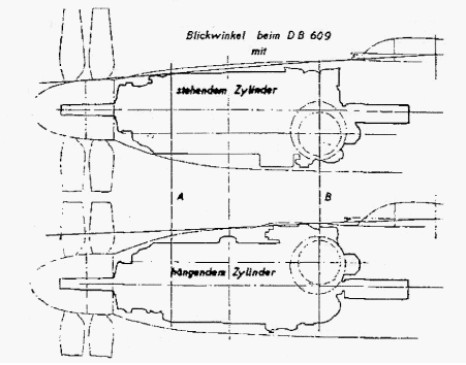
"Daimler-Benz, DB-609 installation drawing"
-In the shaded illustration below, we see the DB-609 with cylinders in inverted V and clearly the eight cylinders of the left block.

"DB-609"
-The next engine of this group of new-design engines during the first stage of the war was the DB-630, a 36 cylinder engine in six blocks of 6 cylinders located around the crankshaft but not in a regular way as we see in the figure below, they looked like two W motors on both sides. It reached 4,000 CV. It was Dr. Berger's idea.
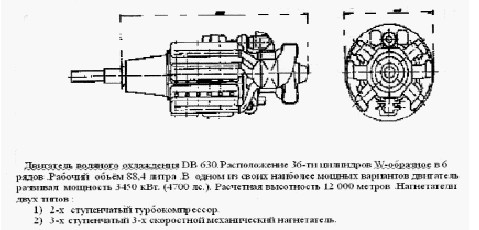
"DB-630"
-Now we come to the special variants, which were the DB-607, DB-612 and the DB-632, all using the same essential parts like crankshaft, blocks and benches.
-The DB-607 was a Diesel engine and was based on the DB-603, also Diesel. The DB-607 reached the 1,750 CV and was designed for long-distance aircraft although the project was finally parked.
-While gasoline engines had a compression ratio of between 7 and 8.5, the DB-607 reached 17 and 18 compression ratio, to produce self-ignition of the fuel.
-The DB-612 had an important variant in the cylinder heads, since it did not have so-called "mushroom" valves but rotating discs with holes like the Burt-McCollum sliding-sleeve system.
-When the discs rotated, they coincided with the admission and exhaust ports. The project seemed simple but it did not prosper, in favor of the classic engines. Certainly the engine was less high and better suited for certain aircraft structures.
-For more detail about this engine, better refer to the main text. Here we offer only a general photo of the Russian text.

"DB-612"
-The DB-632 was a modified DB-603N to drive contra-rotating propellers. It had a reduction of 0.42, and was designed for a high-altitude aircraft, which was a Me-109 model that was planned and in development, the P-1091.
-The power of the DB-632 was 2,400 CV with a two-stage mechanical supercharger capable of reaching 11,000 meters (36,000 ft) in altitude with sufficient operational power.
-This engine was discontinued in favor of the DB-628 that was more advanced.
-The double or matched engines were the DB-606 (2x 601), the DB-610 (2x605), the DB-613 (2x603), the DB-615 (2x614), the DB-618 (2x617), the DB -619 (2x609), DB-620 (2x628) and DB-630 (2xW18 = W36)
-However, to obtain higher altitudes, superchargers and turbochargers were added to the same engines, perfectly adapted to their mechanical architecture.
-The DB 627 was a high-altitude prototype based on the DB-603, with mechanical supercharger compressor mounted on both sides of the engine for 2,000 CV and an operating altitude of 11,500 meters (37730 ft).
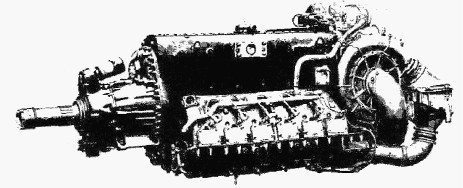
"DB-627"
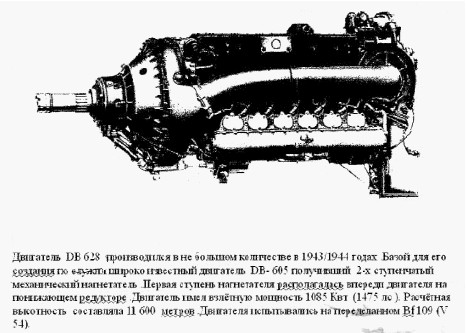
"DB-628"
-The DB-628 was based on the DB-605 with a first supercharger stage at the front of the engine on the gearbox housing. This was done to give the optimum power at 11,000 meters altitude.
-From this compression stage the air was channeled to the subsequent overpressure. It gave 1,475 CV. In the tests carried out on a Me-109 in 1943 it went up to 15,000 meters (49,212 ft). Despite this, the project was suspended in favor of other solutions.

"DB-603A"
-The DB-603 had an added turbocharger placed in the aft of the airplane or engine nacelle as in this case of the Do-217 that was prepared for this purpose.
-The turbo was a TK-11 model, behind the wheel of the main train, but the set turned out to be very heavy.
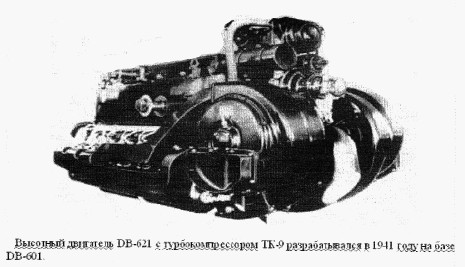
"DB-621"
-The DB-621 was tested in 1941 and had a double turbocharger, type TK-9.
-The DB-624 was developed in 1944 on the basis of the DB-603. with the possibility of operating at 17,000 meters (55774 ft). It has superchargers on both sides at the rear and an intercooler (exchanger) on top of both.
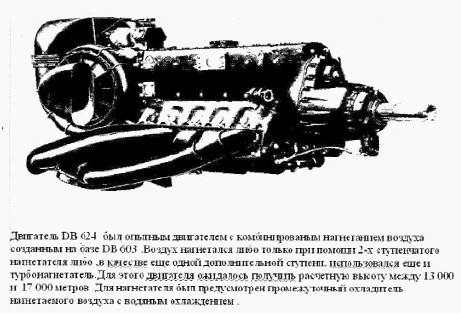
"DB-624"
-Another very interesting model is the DB-615 with two engines placed in tandem, but placed reversed one behind the other so that with two coaxial propellers, one engine rotated in the opposite direction of the other.
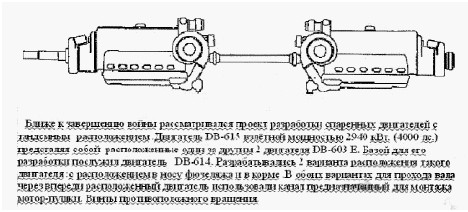
"DB-615"
-The formula of opposite tandem engines could be inspired by the Fiat AS-6 of the Schneider Trophy or the Hispano-Suiza that Arsenal fitted with Vernisse transmissions. (in this case right after WWII).
-In this Russian blog there is an unknown Daimler Benz engine with 24 cylinders in "H". A front gearbox gathers the outputs of the two crankshafts, but maintains the rotation of each one individually to obtain two coaxial shafts for two contra-rotating propellers.
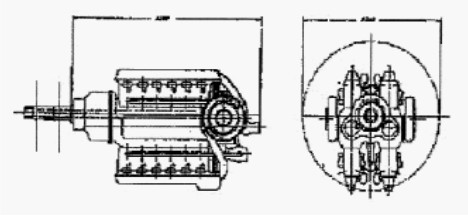
"Daimler Benz H-24 drawing"
-Another capital project was uniting four V-12, type DB-603 engines, to reach 6,000 CV, with a huge fairing, a large gearbox and front radiators.
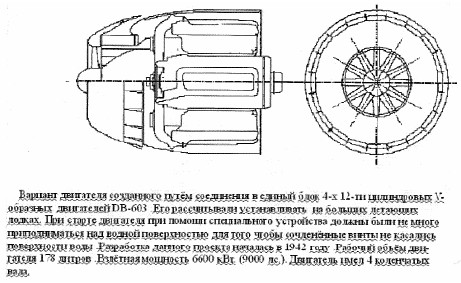
"Daimler Benz DB-603 drawing"
From Appendix 13: We have found more material on DB-609:
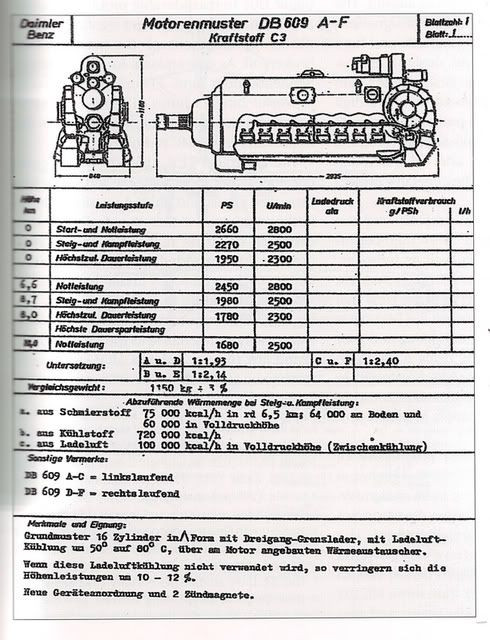
"DB-609 data-sheet"
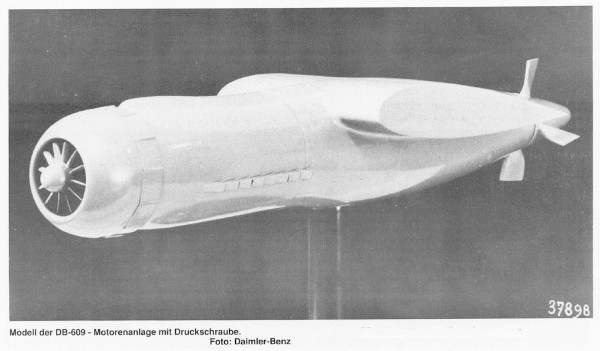
"DB-609 in nacelle with thrust propeller"
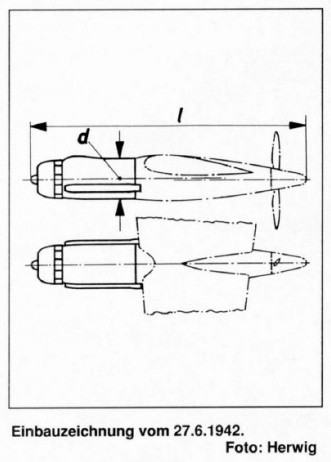
"DB 609, mounting position with pusher propeller"

"DB 609, position in mounting with puller propeller"
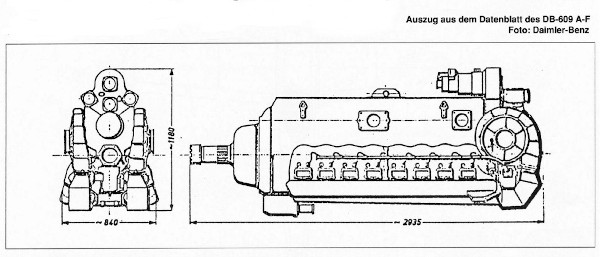
"DB 609, Back and Side View Drawings"


